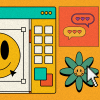The Gen Z guide to smarter learning

There was a time when learning meant dragging yourself to the library, flipping through thick textbooks, and pretending to understand the same paragraph for the third time. But now, it is as easy as typing a question into a chat box and getting an answer in seconds. But with that convenience comes a bigger challenge, because how do we make sure we are learning smarter and not just faster?
For Gen Z students who have grown up navigating both online classes and algorithmic chaos, learning smarter isn't about working harder or longer. It is about using the right tools with the right mindset. So here is how AI can help you learn faster, better, and more efficiently, all without turning your brain into autopilot.
Turn AI into your personal summariser
One of the most powerful uses of AI is condensing dense material into bite-sized insights. Tools like ChatGPT, Perplexity, and Notion AI can digest lengthy textbook chapters, research papers, or lecture slides into concise summaries that still capture the core concepts. The trick is to prompt AI with precision, so do not just ask AI to summarise the chapter. Instead, say, "summarise this chapter into 5 key concepts with real-world examples and potential applications". You can even layer follow-up prompts to extract definitions, highlight contradictions, or create analogies that make the material more memorable. The real value is not just in saving time but in using the AI-generated summary as a scaffold for your own notes. Once AI gives you a base, actively rewrite it in your own words, add diagrams, or test yourself on each point. This ensures that you internalise the information, rather than passively copying it.
Build personalised learning plans
AI excels at structuring chaos. For students juggling multiple courses, side projects, or skill-building, a generic study schedule rarely works. You can use AI to generate a personalised learning plan based on your goals, available time, and pain points. For example, tell ChatGPT: "I have two weeks to prepare for a statistics exam, with 3 hours per day available, and I struggle with probability distributions". The AI can create a day-by-day plan, segmenting study sessions into digestible blocks, highlighting which chapters to tackle first, and suggesting revision intervals. You can even integrate this plan into Notion, Google Calendar, or Todoist to track progress, set reminders, and adjust dynamically as deadlines shift. By doing this, you replace generic advice with a roadmap tailored for your exact strengths, weaknesses, and availability, making study sessions far more productive. Do note that the more honest you are about your habits, the better AI can design a system that keeps you accountable without the guilt of missing one day.
Use AI for active skill-building, not passive consumption
AI is not just for absorbing knowledge, as it can also help you practice and apply skills in real-time. For coding, tools like Replit's AI assistant can generate starter code, explain syntax, or debug errors. In design or UI/UX, AI like Whimsical or Canva Magic Studio can help you wireframe projects or create prototypes quickly, letting you focus on creativity and iteration instead of starting from scratch. Even for writing, AI can help structure essays, summarise research, or draft ideas; however, the magic lies in how you actively engage. Do not just accept the outputs; test them, critique them, and improve upon them. For example, if AI generates a draft essay, challenge yourself to add original examples, refine arguments, or restructure paragraphs. This method ensures that AI acts as a thinking partner, helping you skill up faster while still engaging your own reasoning.
Create a master sheet for learning and tracking
Staying organised is half the battle, and AI can help you centralise all learning tasks, deadlines, and progress metrics in one place. A master sheet can track everything from assignments, online courses, projects, and practice exercises to AI-generated summaries. You can automate this by prompting AI: "Create a Google Sheets template to track chapters read, AI summaries generated, hours studied, and comprehension level for each topic". By keeping everything in one place, you turn your learning into data you can analyse, and once it is set up, you can log daily progress, mark weak areas, and ask AI to suggest adjustments based on patterns. For instance, highlighting chapters that need more revision or recommending extra practice in problem areas.
Use AI for critical thinking, not just answers
Perhaps the most advanced trick is treating AI as a sparring partner for your brain. Instead of relying on it to provide definitive answers, use it to test hypotheses, challenge assumptions, or brainstorm perspectives. For example, if you are writing a paper on environmental economics, ask AI: "List five counterarguments to the argument that carbon taxes reduce emissions." Then evaluate each one, research it further, and decide which holds weight. This not only deepens understanding but also trains your critical thinking muscles, ensuring that AI does not replace reasoning but enhances it. Another example is creating "what if" scenarios in complex subjects like strategy, marketing, or physics, where AI can suggest possible outcomes or alternative frameworks, which you then analyse and debate. The key is to approach AI outputs with curiosity, scepticism, and creativity, transforming them into a learning accelerant rather than a crutch.
Create spaced repetition and testing routines
Another layer to smarter learning is using AI to create spaced repetition systems and testing routines. Tools like Anki, Quizlet, or even ChatGPT prompts can turn summaries into active flashcards or practice questions. By feeding AI-generated notes into these systems, you ensure that what you learn sticks long-term. For example, if AI condenses a chapter into five core concepts, you can ask it to create 10 multiple-choice questions, 5 scenario-based exercises, and 3 real-world application prompts. You then cycle through these daily or weekly, reinforcing memory while identifying weak spots. The real power comes from the combination: AI handles repetitive or clerical work, leaving you to focus on comprehension, application, and reflection. You can set up a schedule where you cycle through these exercises daily, weekly, or monthly, ensuring repeated exposure to the material at intervals scientifically designed to optimise retention.
Throughout all these approaches, it is vital to remain cautious and critical. AI is not infallible, and misinformation can slip through if prompts are ambiguous or sources are unverified. Always cross-check facts, verify calculations, and question assumptions. Think of AI as a powerful assistant, not a replacement for reasoning. Engage actively with its outputs, debate them, and integrate them into your own framework of understanding. It is a partnership as the AI gives you efficiency, breadth, and suggestions, while you provide context, judgment, and nuance.

 For all latest news, follow The Daily Star's Google News channel.
For all latest news, follow The Daily Star's Google News channel. 








Comments